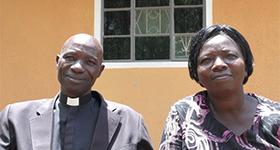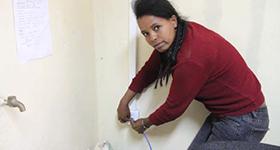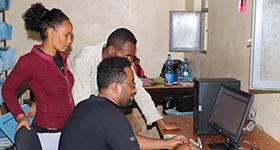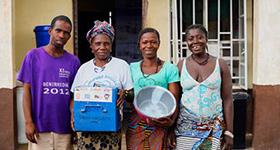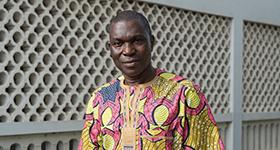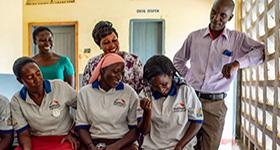Background
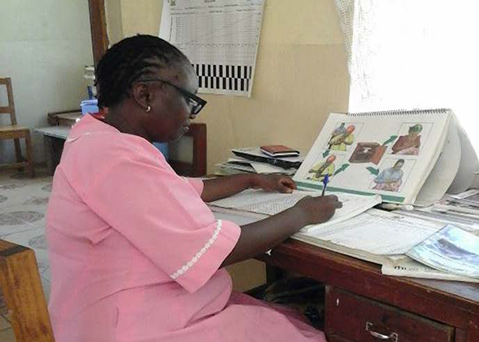
Victoria Kamara, the facility in-charge, working on her daily reports.
“Sustaining the smooth running of the PHU used to be a major challenge for us,” says Victoria Kamara, the in-charge nurse at the Mayossoh Maternal and Child Health Post (MCHP) in Tonkolili District. After the Peripheral Health Unit (PHU) in Mayossoh community was rehabilitated in 2017 with funding from the U.S. Agency for International Development (USAID), the Facility Management Committee (FMC) was established to link the community with the PHU and support the facility’s maintenance. Unfortunately, the FMC was unable to hold meetings consistently to discuss and address issues affecting the operations of the PHU.
Because of this, the facility staff faced challenges at the PHU. For minor repairs and maintenance, they had to wait for support from a nongovernmental organizations or the government. At the same time, the catchment population in the Mayossoh area was increasing, putting pressure on the PHU’s limited resources. The PHU’s catchment population is about 3,000, but because of its location within the chiefdom, many members of other communities from beyond the catchment area frequent the facility. “On maternal health clinic days, we didn’t have space to accommodate everyone. People would sit outside on the ground to wait,” said Victoria.
Intervention
In November 2018, the Advancing Partners & Communities project came to Mayossoh MCHP to meet with the FMC. They provided refresher training to the FMC on their role in supporting and maintaining the facility. Over the next few weeks, the project helped the FMC to review and update the Facility Improvement Action Plan (FIAP) and discuss how the FMC and the surrounding communities could support the implementation of the plan by mobilizing their own resources. The FMC members were also trained in fund management, advocacy, and use of Community Score Cards to evaluate service quality at their PHU. They also received training in establishing Village Savings and Loan Associations (VSLA), an effective tool for community economic development, with the goal of using some of the VSLA funds to maintain the health facility.
After the FMC updated the FIAP, they met with the community. Together they committed to repairing the hand-dug well, rehabilitating the perimeter fence around the PHU, and constructing a new latrine and a shed to host lactating mothers and pregnant women, while they wait to be seen on immunization and clinic days.
Outcomes
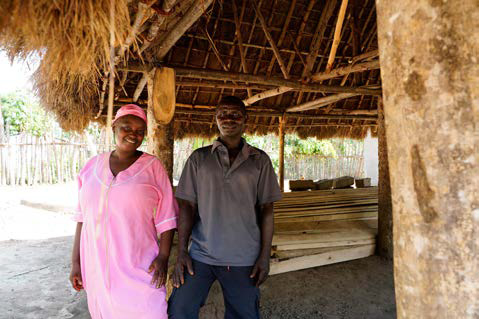
Victoria Kamara, in-charge, and David Tarawali, FMC Chair, in the waiting area constructed by the community.
Within just a few months, the FMC worked with the community to mobilize resources to conduct the repairs and undertake some construction to improve the PHU. By April 2019, the community had completed the perimeter fence, repaired the well, and almost finished building the new waiting area. This impressive amount of work shows the strength of the community’s renewed commitment to its PHU.
Numerous factors contributed to this effective community resource mobilization. First, the FMC generated revenue using creative means—for example, the FMC held a community dance to raise funds for the facility. They also connected with the newly established VSLAs and convinced the groups to allow the PHU to access their “social fund,” a small amount of money collected from VSLA members for emergency needs, for minor repairs at the PHU.
Second, the community has come to view the improvement they are making as a long-term investment—which is why they chose to use plum branches for the perimeter fence. The branches will grow, develop roots, and form a strong and long-lasting fence.
Since the FMC’s revitalization, there has been a visible improvement in attendance at the health facility, and more people are coming for treatment.
“This week we treated 30 lactating mothers and 10 pregnant women. When compared to early 2018, we used to treat 10 lactating mother and 6 pregnant women per week. We think this is because the FMCs are helping us to encourage women to seek medical service at the PHU.”
—Kadiatu Kata, Nurse Aid, Mayossoh MCHP
When people are considering their health needs, they are more likely to come to a facility if they know it will be safe, clean, and well maintained.
The facility staff have built a cordial relationship with the patients. This makes women feel confident in their health care provider and more willing to come to the PHU for care and to discuss family planning.
Thanks to creative community resource mobilization, the community is now empowered to support their PHU, take action to address problems, and ensure that their health facility is maintained in good condition.

